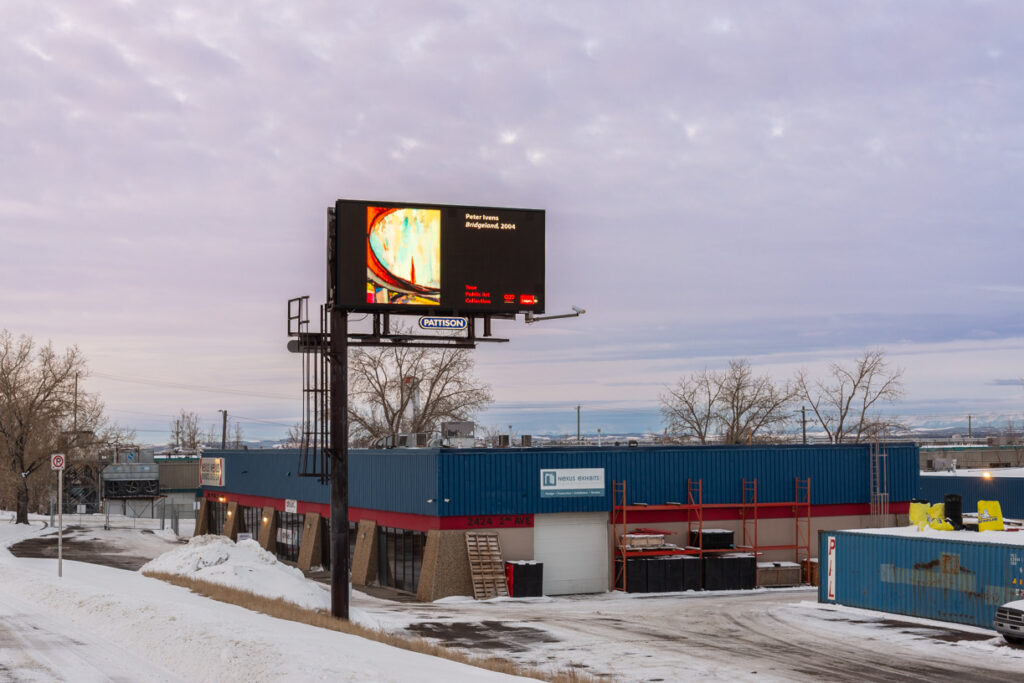The Program
Now Touring: Public Art Billboards shines a spotlight on artwork from Calgary’s Public Art Collection by making it part of people’s daily commutes. Selected by Calgary Public Art Lead Curator Sophia Lebessis, these works are currently in storage and not on display to the public.
Through the selection process, Lebessis had a chance to sit down with the artists to talk about their artwork and artistic practice.
Curatorial Reflections by Sophia Lebessis
As you walk through the storage facility housing The City of Calgary’s Civic Art Collection, the pieces compete for your attention. As an art dealer, your eye is trained to view works in confined spaces. As an art collector, when you acquire a piece and stage it in your home, the piece stops competing and takes on a life of its own.
It’s now content.
This is the power of art when it makes its way home. Home is one of the most beautiful words.
Each artist featured in the Public Art Billboards program currently calls Calgary home, which is why I named this series HOME.
To appreciate the featured works in this series, I set out to have a conversation, virtually, with each artist to go beyond their biography and into their memories.
Now, virtual meetings tend to be dull. I think we’ve all felt the monotony of staring into a screen. It’s exhausting. But when you meet virtually with an artist, it’s a different story. Your eye wanders around the screen, catching glimpses of their creative process in the background. An artist needs an audience, so we light up in different ways that the camera loves. Each artist was open with their memories. It was like show and tell as they would hold objects up to the camera for me to see. I got to meet some of their spouses and was invited over for tea, dinner, and art viewings.
My most memorable virtual meeting must go to Simon Wong, who paints with ink wash on rice paper. I was so curious about this process and got a live demonstration. Wong grabbed a piece of rice paper to show me how malleable it is. He folded it, crushed it, used a paint brush to apply water where he wanted black ink to go, and the result was a work of art.
Each artist loved the concept of HOME. I think it’s important to celebrate our hometown artists, and when conversation between artists flows freely, we open up layers of our being that are often vulnerable and beautiful. Memories that artists share help us understand their art. Artists’ memories shape the power of their work.
If Ray Van Nes never met his Scottish geologist friend with an interest in 35mm film, would he be inspired to take the artistic path that led him to the Deardorff wooden view camera? What a Renaissance man. I hope there’s a revival of his photography that celebrates our city’s sandstone building history.
Greg Payce, a ceramic artist, gave me a history lesson in Alberta’s Medalta Potteries, which was a large Canadian ceramics factory in Medicine Hat. The area’s natural abundance of clay ensured employment by producing ceramic products during a turbulent economy.
In my conversation with William Laing, an established printmaker, he shared that his very first print was titled Home. We connected on the loneliness of being an artist and how isolating it can be.
Terrance Houle shared that he knew this feeling all too well, growing up in Calgary as an Indigenous contemporary artist. I think all artists can related to isolation, but isolation breeds ingenuity, a trait Houle has mastered. He also caught the attention of Elton John, who he held a private art show for during his residency at the Hyatt Hotel. Elton John would have his morning tea and biscuits to a landscape portrait made by Houle.
I think Ivens put it well, ‘an artist can expand in all directions when you’re rooted in home.’
It was a pleasure getting to know all these artists from our city who inspired the concept of HOME, whose works offer different reflections on what it means to call a place home. I’ve called Calgary home since 2002 and was instantly adopted into the Treaty 7 arts community. In recognition of time and location, the original peoples of Calgary have always shared their home with us.
I hope you enjoy the pieces I selected for you.
Select an artist below to learn more.
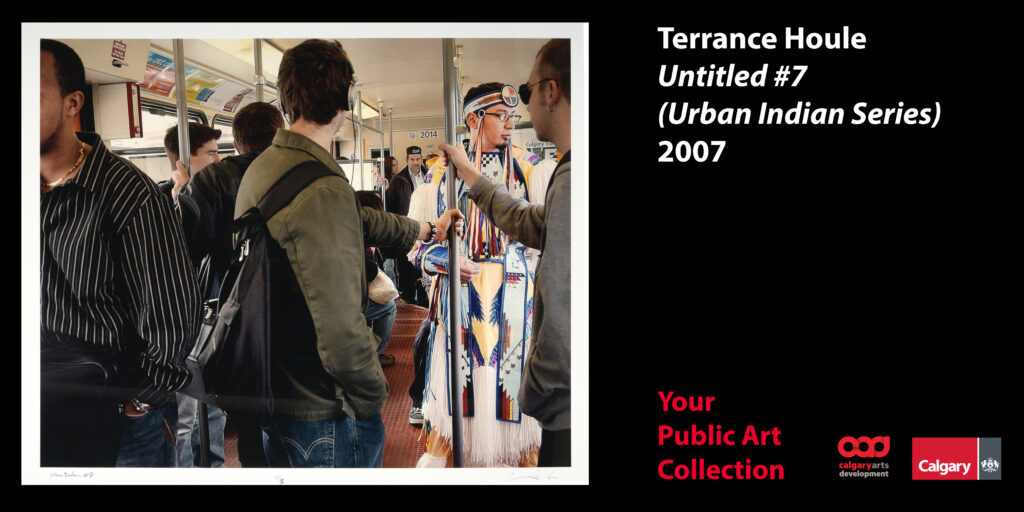
Urban Indian Series #7, digital print on paper, 2007
An experimental artist, Terrance Houle is from Kainai Nation and works in the space of photography, fiber and textiles, music, installation art, printmaking, performance art, dance, theatre and film.
The Ojibway Blackfoot artist says he that he grew up a ‘military brat.’ His father served in the military and a lot of his work is based on his family’s life, a life rich in culture in action.
What was Houle’s urban Indigenous experience like in Calgary? What experiences did contemporary Indigenous artists have in Calgary? There’s something provoking and intellectual in Urban Indian Series #7. To Houle, there’s also an element of humour.
He grew up in the ’90s punk-metal skate scene in Calgary. Being a contemporary Indigenous artist in Calgary wasn’t always easy and often lonely when your peers left Calgary to pursue a career in the arts.
Urban Indian Series #7 was a series of eight photographs taken in collaboration with his friend Jarusha Brown. The concept of the shoot was to showcase a day in the life on an urban Indigenous person. Houle reflects on that day, remembering how the elements of the photo were a bit cheeky, a nod to his life growing up on the powwow circuit, and the public perception of Indigenous people, both positive and negative.
His latest offering is a photo mural tribute to his late mother, Maxine Weasel Fat, titled Ipasskaa (Dance), installed at Red Crow College in Standoff, Alberta, Kainai Nation. The photo mural is a tribute to his mother’s artwork and regalia, and beadwork she made for his family over the years.
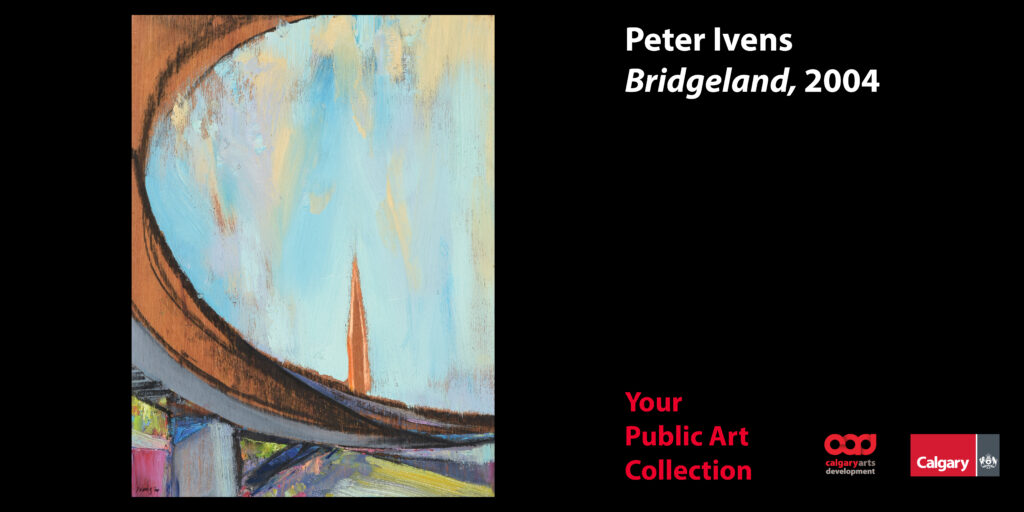
Bridgeland, oil on panel, 2004
At the time Peter Ivens painted Bridgeland, he was sharing art studio space in Ramsay with high ceilings and a skylight. It was a fateful stuck-in-traffic moment during his drive to the studio that inspired him to paint that view, from that exact location.
Ivens has seen our city grow up. To him, home is an old friend. Over the last 10 years Ivens has found a rejuvenation in his craft, affectionally referring to this phase in his practice as a time to focus on what matters in life.
His connection to the landscape of Calgary is the source of his artistry. Inspired by the big horizon of the West and an appreciation for the urban landscape, he’s able to expand in all directions art takes him because he’s rooted to the warm and welcoming sense he gets from home.
Born in Saskatoon, Ivens moved to Calgary in 1964 and graduated with a fine arts degree from the University of Alberta. He has worked as an illustrator, designer and art instructor.
Ivens’ art has been embraced by Western Canada, and one could attribute this to his fond sense of home and the emotional attachment that instills in him. During a trip to Europe, Ivens reconciled with the meaning of home as it relates to his artistic philosophy. As stunning as the European landscape and architecture is, to Ivens, it wasn’t his home to paint. What a beautiful viewpoint.
You can find his work available for sale at the Collectors’ Gallery of Art in Inglewood and the Art Gallery of Saint Albert.
Follow him on Instagram @ivensart
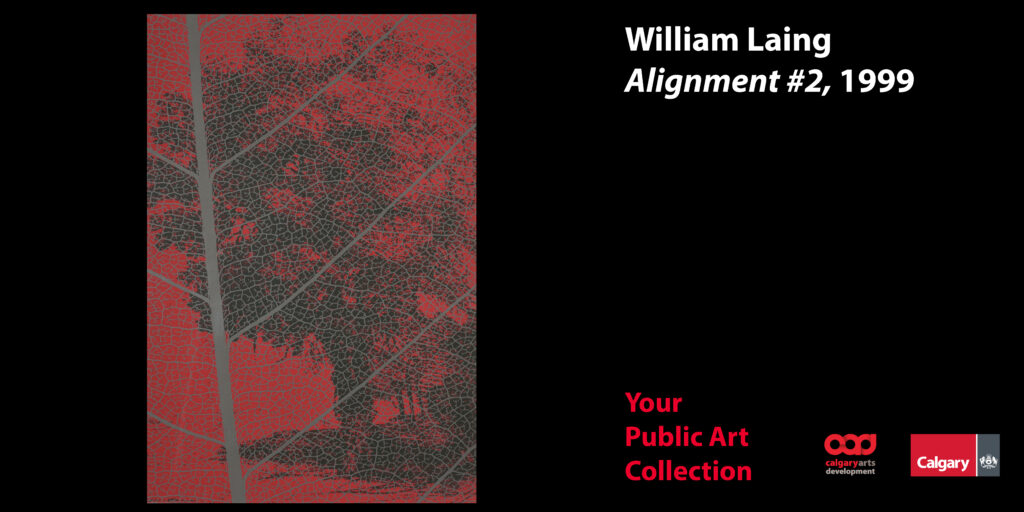
Alignment #2, serigraph, 1999
If you were fortunate to have William Laing as an art instructor at the University of Calgary, you were taught to look at things with all your senses. When you do that, you see it differently, and from there an artist can start asking questions for their craft to answer.
Alignment #2 is a series of two serigraph prints. During a walk, Laing came across a piece of wood that was weather worn. He took a photo of it and asked himself, what happens to trees? Alignment #2 helped answer that question.
Another question an artist may ask, what happens to my art when it gets sold? In a rare moment of happenstance, as Laing sat in traffic, a glance into someone’s living room window showed a print of his hung on the wall. It put a smile on his face, and hopefully one on every artist out there asking themselves the same question.
Laing immigrated to Canada in the 1960s with his grandparents. His mother passed away at a young age, and it was his grandmother, an avid gardener, who gave him an appreciation for nature. From there his artistry was born.
A dedicated student of the arts, he studied at the Vancouver School of Art, Brighton Polytechnic in England and received his master’s degree from the Royal College of Art in London, England. Laing came back to Canada to teach at the Alberta College of Art and Design and the University of Calgary. With over 500 group shows and 50 solo shows, Laing has been inducted into the Royal Canadian Academy of Arts. His works can be found Herringer Kiss Gallery in Calgary.
You can find his work here: https://www.herringerkissgallery.com/bill-laing
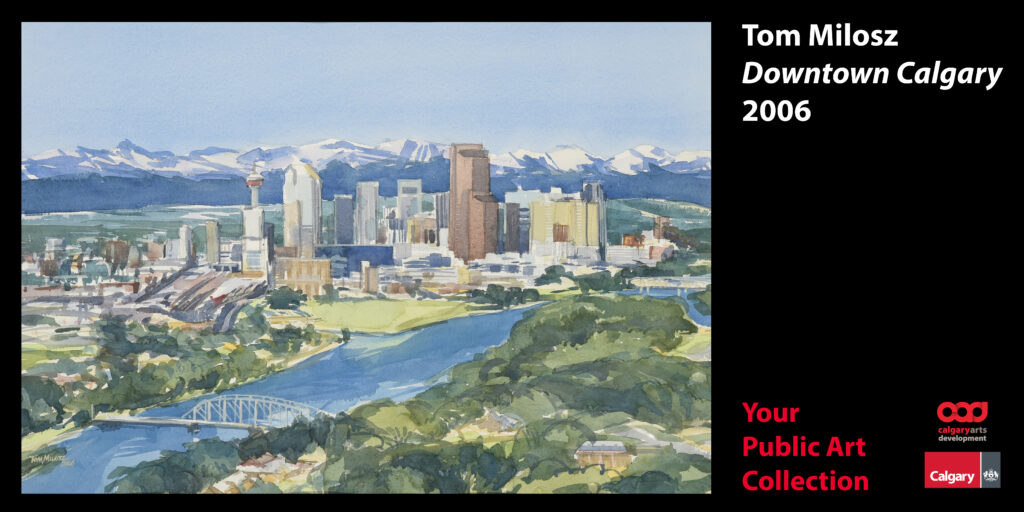
Downtown Calgary, watercolour on paper, 2006
Watercolour artist Tom Milosz often creates work ‘en plein air,’ or ’in open air,’ which is a French term for painting landscapes outdoors to capture the impressions of the locations.
While Milosz was working as a graphic designer at The City of Calgary’s Creative Services department, he painted downtown Calgary as a marketing image for the 2007 Canadian Association of Municipal Administrators Convention. Now retired, Milosz and his wife Kathleen are a dynamic duo, selling art through friends and word of mouth.
Born in Coleman, Alberta, Milosz has lived in Southern Alberta his whole life and his home studio houses thousands of watercolour paintings amassed over 46 years of being an artist.
The Centennial Gallery in the Calgary Tower carried his works from 1986 to 2015. Many of his paintings are held in private collections throughout North America and Australia. Milosz was a member of the Calgary Artist’s Society and the Alberta Society of Artists. He studied Advertising Visual Communication at the Alberta College of Art (now the Alberta University of the Arts) where he graduated in 1974.
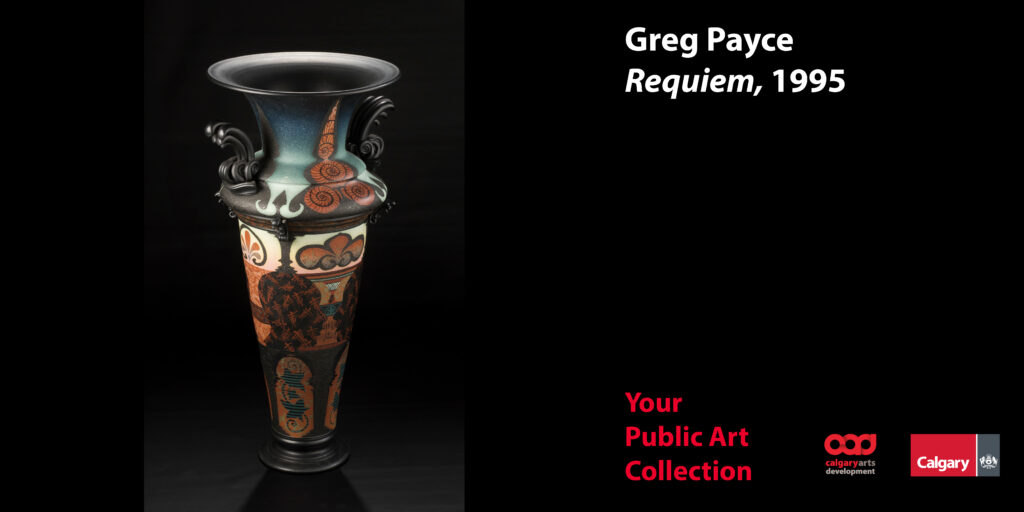
Requiem, ceramic, 1995
Greg Payce, born in Edmonton, and his wife Laura Vickerson (also an artist) have called Calgary home since 1988 when he started an over 25-year career teaching ceramics at the Alberta University of the Arts (previously named the Alberta College of Art and Design).
Ceramics, an ancient medium blending form and function, often serves as evidence of a distant past, telling us stories about people’s lives. To Payce, ceramics is an art form of a continuum, ages old with an infinite amount of potential. Ceramics history dates as far back as the Geometric Period, and continues today. Payce’s practice is a notable contribution to this long-established discipline of ceramic arts, as he has over 30 solo exhibitions and 150 group exhibitions in Canada and abroad. His works are collected by over 30 public galleries.
In Requiem, Payce sculpts two faces representing the East and West communicating with each other, set amongst imagery of octopus tentacles, English ivy, and Greek and Asian-inspired designs. It was made during a time when he was inspired by architecture. This piece marked the end of a series of vessels made in the mid-1990s. The title of the work pays homage to the death of his elderly neighbour. Requiem was completed the day the neighbour passed away.
It was made on a potter’s wheel using red earthenware clay and Terra Sigillata slips using latex resist processes.
Payce received the Governor General’s Award for Media and Visual Arts and the Saidye Bronfman Award for Fine Craft in 2013. In 2015, he retired from teaching at the Alberta University of the Arts and is currently Professor Emeritus. His joint ceramics show at Messums Gallery in Wiltshire, UK, titled Liminal and Lenticular, brought together the work of Payce and Nicholas Lees.
Follow him on Instagram @gregpayce.
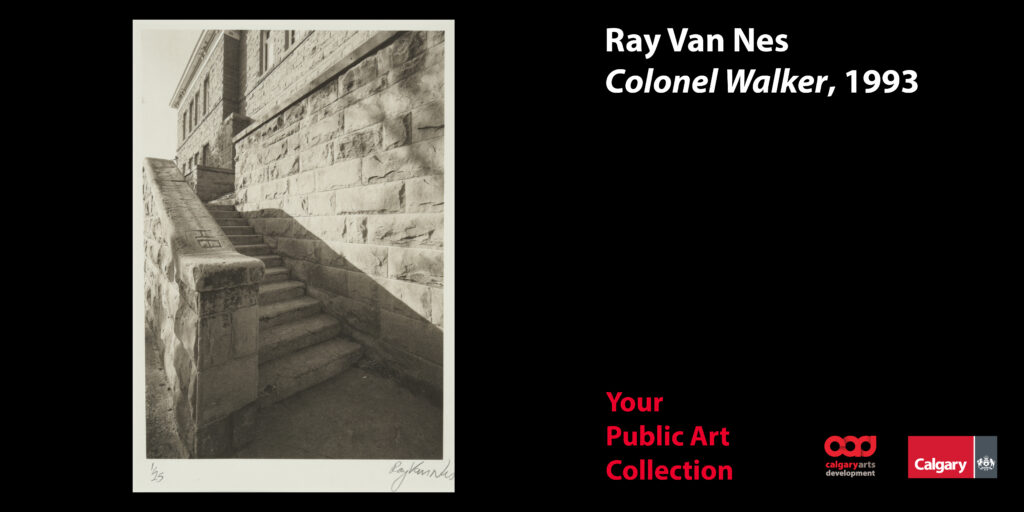
Colonel Walker School, Palladium on print paper, 1993
Out of all forms of photography, platinum palladium photography is rare.
As Ray Van Nes describes his 5×7 Deardorff wooden view camera with a 90mm Nikkon lens, ones imagination is transported to a time in photography history that produced beautifully saturated images. One could look as far back in photography history to Plato’s pinhole camera. For Van Nes, the Deardorff camera, made before the Second World War, is from an era of photography technology that best captured images of Calgary’s sandstone structures built in the late 1880s. These structures mark in a pivotal time in the construction of Calgary, then dubbed The Sandstone City.
Colonel Walker School was a part of a series of photographs of sandstone buildings. Lucky for us, the negatives from these series have been donated to the National Architectural Achieves at the University of Calgary. The photos were developed on film trays in a developer known as pyro.
Ray Van Nes was born in Victoria, BC and spent much of his life in Alberta. Having previously called Cold Lake and Edmonton home, Ray moved to Calgary in 1972.
As a young adult, Ray Van Nes was inspired by his Scottish geologist friend, a polymath, with interests in jazz, geology and photography. It was his friend’s 35mm slides that piqued his interest, and from there he dedicated himself to the art of film photography.
Has he ever worked in digital photography? The answer is an immediate no, and he has no real interest. Did we expect any other answer?
Yet, he doesn’t consider himself a professional artist and views his craft as a hobby. One could only hope that the next generation of Calgary photographers will discover the Renaissance man that is Ray Van Nes and be inspired to continue the art of platinum palladium photo processing, and the Deardorff wooden view camera.
Follow Van Nes on Facebook @Rayvannes.
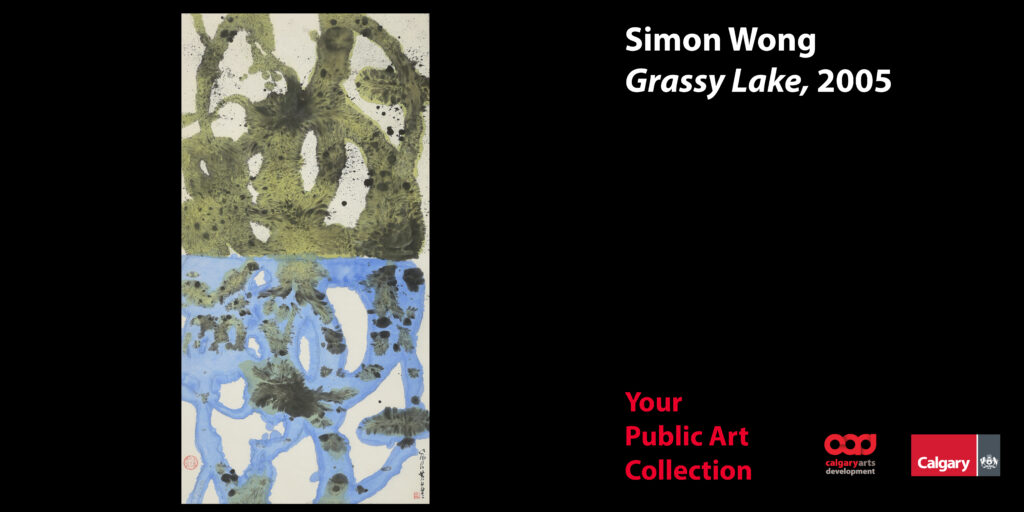
Grassy Lake, Ink and wash on paper, 2005
Inspired by music, sounds and shapes, Simon Wong’s 50-year art career has been nothing short of innovative as he harmonizes Eastern and Western art techniques and philosophies.
Named for Grassi Lakes near Canmore, Wong was inspired by the mirror-like surface of the lake for this piece. It was created on rice paper, which Wong describes as elegant, using ink with different tones — much like music. The reflection of the mountains and sky on the lake is similar to how ink wash flows on rice paper.
Water is the conduit to his art form — it’s how ink wash on rice paper moves. He places water onto the rice paper before adding ink. The ink follows the water.
Some of you may have had the opportunity to eat at his former restaurant, China Express, back in 1988. Mr. Wong would host artist dinners where attendees could eat together with artists and watch them create live works. His memories of these days highlighted an artist of great verve, Norval Morrisseau, also known as the ‘Picasso of the North.’ He and Morrisseau traded art together, and Morrisseau was a big fan of Wong’s calligraphy work.
In his calligraphy, the calm and meditative nature of the artform is a peaceful process for Wong and a practice he likes to share in live demonstrations. Most notably, his live painting demonstration accompanied by a Chinese orchestral band at Mount Royal University’s Bella Concert Hall resulted in a 35-foot-long painting inspired by the music.
Even after a 50-year career, Wong still considers himself a student of the arts, remains curious about developing new twists on traditional art forms. How does he stay inspired? This year, a trip to China for a food and art retreat to re-connect with people and nature.
Learn more about Simon Wong on his website: https://www.simonysart.ca/.
